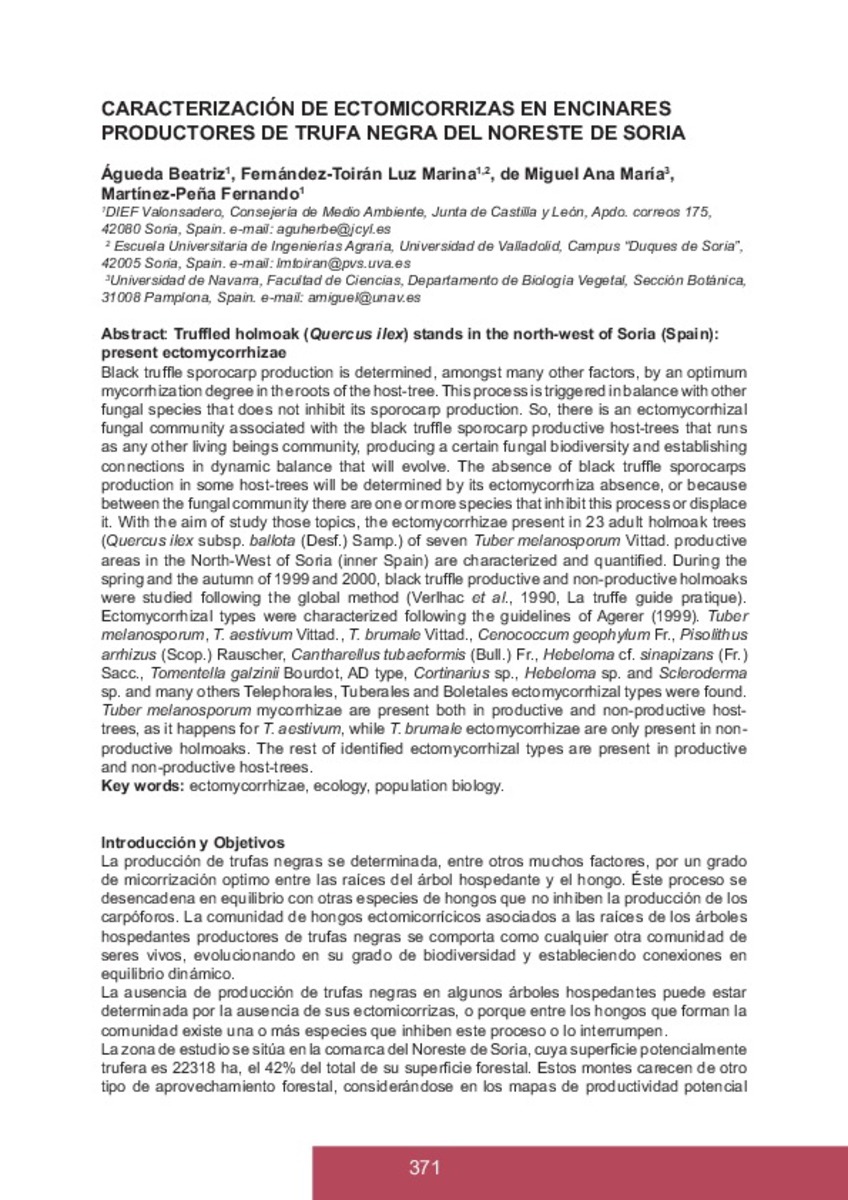Registro completo de metadatos
| Campo DC | Valor | Lengua/Idioma |
|---|---|---|
| dc.creator | Agueda, B. (Beatriz) | - |
| dc.creator | Fernandez-Toiran, L.M. (Luz Marina) | - |
| dc.creator | Miguel-Velasco, A.M. (Ana Maria) de | - |
| dc.creator | Martinez-Peña, F. (Fernando) | - |
| dc.date.accessioned | 2012-05-14T12:29:40Z | - |
| dc.date.available | 2012-05-14T12:29:40Z | - |
| dc.date.issued | 2010 | - |
| dc.identifier.citation | Agueda B, Fernandez-Toiran LM, De Miguel AM, Martinez-Peña F. Caracterización de ectomicorrizas en encinares productores de trufa negra del noreste de Soria. En: 3º Congresso Internazionale di Spoleto sul Tartufo; 2008 Nov 25-28; Spoleto, Italia. [s.l.]: Comunità Montana dei Monti Martani Serano e Subasio, 2010. p. 371-382. | es_ES |
| dc.identifier.isbn | 9788890512209 | - |
| dc.identifier.uri | https://hdl.handle.net/10171/22055 | - |
| dc.description.abstract | Black truffle sporocarp production is determined, amongst many other factors, by an optimum mycorrhization degree in the roots of the host-tree. This process is triggered in balance with other fungal species that does not inhibit its sporocarp production. So, there is an ectomycorrhizal fungal community associated with the black truffle sporocarp productive host-trees that runs as any other living beings community, producing a certain fungal biodiversity and establishing connections in dynamic balance that will evolve. The absence of black truffle sporocarps production in some host-trees will be determined by its ectomycorrhiza absence, or because between the fungal community there are one or more species that inhibit this process or displace it. With the aim of study those topics, the ectomycorrhizae present in 23 adult holmoak trees (Quercus ilex subsp. ballota (Desf.) Samp.) of seven Tuber melanosporum Vittad. productive areas in the North-West of Soria (inner Spain) are characterized and quantified. During the spring and the autumn of 1999 and 2000, black truffle productive and non-productive holmoaks were studied following the global method (Verlhac et al., 1990, La truffe guide pratique). Ectomycorrhizal types were characterized following the guidelines of Agerer (1999). Tuber melanosporum, T. aestivum Vittad., T. brumale Vittad., Cenococcum geophylum Fr., Pisolithus arrhizus (Scop.) Rauscher, Cantharellus tubaeformis (Bull.) Fr., Hebeloma cf. sinapizans (Fr.) Sacc., Tomentella galzinii Bourdot, AD type, Cortinarius sp., Hebeloma sp. and Scleroderma sp. and many others Telephorales, Tuberales and Boletales ectomycorrhizal types were found. Tuber melanosporum mycorrhizae are present both in productive and non-productive hosttrees, as it happens for T. aestivum, while T. brumale ectomycorrhizae are only present in nonproductive holmoaks. The rest of identified ectomycorrhizal types are present in productive and non-productive host-trees. | es_ES |
| dc.language.iso | spa | es_ES |
| dc.publisher | Comunità Montana dei Monti Martani Serano e Subasio | es_ES |
| dc.rights | info:eu-repo/semantics/openAccess | es_ES |
| dc.subject | Botánica | es_ES |
| dc.subject | Ectomycorrhizae | es_ES |
| dc.subject | Ecology | es_ES |
| dc.subject | Population biology | es_ES |
| dc.title | Caracterización de ectomicorrizas en encinares productores de trufa negra del noreste de Soria | es_ES |
| dc.type | info:eu-repo/semantics/bookPart | es_ES |
Ficheros en este ítem:
Estadísticas e impacto
Los ítems de Dadun están protegidos por copyright, con todos los derechos reservados, a menos que se indique lo contrario.






